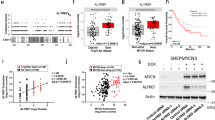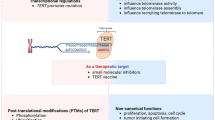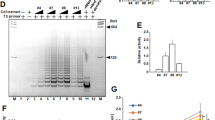Abstract
Telomerase activity, which has fundamental roles in development and carcinogenesis, strongly depends on the expression of human telomerase reverse transcriptase (hTERT), its catalytic subunit. In this report, we show that the basic helix-loop-helix factor, TAL1 (T-cell acute lymphoblastic leukemia 1), is a negative regulator of the hTERT promoter. Indeed, TAL1 overexpression leads to a decrease in hTERT mRNA abundance and hence to reduced telomerase activity. Conversely, suppression of TAL1 by RNA interference in Jurkat cells increases hTERT expression. Analysis by chromatin immunoprecipitation assays showed that TAL1 binds to the hTERT proximal promoter and recruits HDAC1. Considering the relationship recently established between TAL1 and the human T-cell leukemia virus type 1 (HTLV-1) Tax protein, which was confirmed in T lymphocyte clones derived from adult T-cell leukemia patients, we analyzed the effect of TAL1 with respect to the earlier characterized effects of Tax and HBZ (HTLV-1 basic leucine zipper) on hTERT expression. TAL1 was observed to reinforce the negative effect of Tax, whereas hTERT transactivation by the HBZ–JunD complex was repressed by TAL1 overexpression. Moreover, HBZ was found to induce proteasome-mediated degradation of TAL1. These observations support a model in which Tax and TAL1 by repressing hTERT would initially favor genomic instability, whereas expression of factors such as HBZ allows at a later stage an increase in hTERT production and consequently in telomerase activity.
This is a preview of subscription content, access via your institution
Access options
Subscribe to this journal
Receive 12 print issues and online access
$259.00 per year
only $21.58 per issue
Buy this article
- Purchase on Springer Link
- Instant access to full article PDF
Prices may be subject to local taxes which are calculated during checkout







Similar content being viewed by others
References
Gilson E, Geli V . How telomeres are replicated. Nat Rev Mol Cell Biol 2007; 8: 825–838.
Harley CB . Telomerase and cancer therapeutics. Nat Rev Cancer 2008; 8: 167–179.
Cogulu O, Kosova B, Karaca E, Gunduz C, Ozkinay F, Aksoylar S et al. Evaluation of telomerase mRNA (hTERT) in childhood acute leukemia. Leuk Lymphoma 2004; 45: 2477–2480.
Kubuki Y, Suzuki M, Sasaki H, Toyama T, Yamashita K, Maeda K et al. Telomerase activity and telomere length as prognostic factors of adult T-cell leukemia. Leuk Lymphoma 2005; 46: 393–399.
Weinrich SL, Pruzan R, Ma L, Ouellette M, Tesmer VM, Holt SE et al. Reconstitution of human telomerase with the template RNA component hTR and the catalytic protein subunit hTRT. Nat Genet 1997; 17: 498–502.
Koyanagi Y, Kobayashi D, Yajima T, Asanuma K, Kimura T, Sato T et al. Telomerase activity is down regulated via decreases in hTERT mRNA but not TEP1 mRNA or hTERC during the differentiation of leukemic cells. Anticancer Res 2000; 20 (2A): 773–778.
Ohyashiki JH, Ohyashiki K, Fujimura T, Kawakubo K, Shimamoto T, Iwabuchi A et al. Telomere shortening associated with disease evolution patterns in myelodysplastic syndromes. Cancer Res 1994; 54: 3557–3560.
Kyo S, Takakura M, Fujiwara T, Inoue M . Understanding and exploiting hTERT promoter regulation for diagnosis and treatment of human cancers. Cancer Sci 2008; 99: 1528–1538.
Hao H, Nancai Y, Lei F, Xiong W, Wen S, Guofu H et al. siRNA directed against c-Myc inhibits proliferation and downregulates human telomerase reverse transcriptase in human colon cancer Colo 320 cells. J Exp Clin Cancer Res 2008; 27: 27.
Kyo S, Takakura M, Taira T, Kanaya T, Itoh H, Yutsudo M et al. Sp1 cooperates with c-Myc to activate transcription of the human telomerase reverse transcriptase gene (hTERT). Nucleic Acids Res 2000; 28: 669–677.
Lebel R, McDuff FO, Lavigne P, Grandbois M . Direct visualization of the binding of c-Myc/Max heterodimeric b-HLH-LZ to E-box sequences on the hTERT promoter. Biochemistry 2007; 46: 10279–10286.
Xu D, Popov N, Hou M, Wang Q, Bjorkholm M, Gruber A et al. Switch from Myc/Max to Mad1/Max binding and decrease in histone acetylation at the telomerase reverse transcriptase promoter during differentiation of HL60 cells. Proc Natl Acad Sci USA 2001; 98: 3826–3831.
Gabet AS, Mortreux F, Charneau P, Riou P, Duc-Dodon M, Wu Y et al. Inactivation of hTERT transcription by Tax. Oncogene 2003; 22: 3734–3741.
Kuhlmann AS, Villaudy J, Gazzolo L, Castellazzi M, Mesnard JM, Duc Dodon M . HTLV-1 HBZ cooperates with JunD to enhance transcription of the human telomerase reverse transcriptase gene (hTERT). Retrovirology 2007; 4: 92.
O'Neil J, Shank J, Cusson N, Murre C, Kelliher M . TAL1/SCL induces leukemia by inhibiting the transcriptional activity of E47/HEB. Cancer Cell 2004; 5: 587–596.
Terme JM, Wencker M, Favre-Bonvin A, Bex F, Gazzolo L, Duc Dodon M et al. Cross talk between expression of the human T-cell leukemia virus type 1 Tax transactivator and the oncogenic bHLH transcription factor TAL1. J Virol 2008; 82: 7913–7922.
Palomero T, Odom DT, O'Neil J, Ferrando AA, Margolin A, Neuberg DS et al. Transcriptional regulatory networks downstream of TAL1/SCL in T-cell acute lymphoblastic leukemia. Blood 2006; 108: 986–992.
Lecuyer E, Hoang T . SCL: from the origin of hematopoiesis to stem cells and leukemia. Exp Hematol 2004; 32: 11–24.
Huang S, Brandt SJ . mSin3A regulates murine erythroleukemia cell differentiation through association with the TAL1 (or SCL) transcription factor. Mol Cell Biol 2000; 20: 2248–2259.
Huang S, Qiu Y, Stein RW, Brandt SJ . p300 functions as a transcriptional coactivator for the TAL1/SCL oncoprotein. Oncogene 1999; 18: 4958–4967.
Lecuyer E, Herblot S, Saint-Denis M, Martin R, Begley CG, Porcher C et al. The SCL complex regulates c-kit expression in hematopoietic cells through functional interaction with Sp1. Blood 2002; 100: 2430–2440.
Osada H, Grutz G, Axelson H, Forster A, Rabbitts TH . Association of erythroid transcription factors: complexes involving the LIM protein RBTN2 and the zinc-finger protein GATA1. Proc Natl Acad Sci USA 1995; 92: 9585–9589.
Valge-Archer VE, Osada H, Warren AJ, Forster A, Li J, Baer R et al. The LIM protein RBTN2 and the basic helix-loop-helix protein TAL1 are present in a complex in erythroid cells. Proc Natl Acad Sci USA 1994; 91: 8617–8621.
Yao J, Grant C, Harhaj E, Nonnemacher M, Alefantis T, Martin J et al. Regulation of human T-cell leukemia virus type 1 gene expression by Sp1 and Sp3 interaction with TRE-1 repeat III. DNA Cell Biol 2006; 25: 262–276.
Riou P, Bex F, Gazzolo L . The human T cell leukemia/lymphotropic virus type 1 Tax protein represses MyoD-dependent transcription by inhibiting MyoD-binding to the KIX domain of p300. A potential mechanism for Tax-mediated repression of the transcriptional activity of basic helix-loop-helix factors. J Biol Chem 2000; 275: 10551–10560.
Gaudray G, Gachon F, Basbous J, Biard-Piechaczyk M, Devaux C, Mesnard JM . The complementary strand of the human T-cell leukemia virus type 1 RNA genome encodes a bZIP transcription factor that down-regulates viral transcription. J Virol 2002; 76: 12813–12822.
Sibon D, Gabet AS, Zandecki M, Pinatel C, Thete J, Delfau-Larue MH et al. HTLV-1 propels untransformed CD4 lymphocytes into the cell cycle while protecting CD8 cells from death. J Clin Invest 2006; 116: 974–983.
Aplan PD, Lombardi DP, Reaman GH, Sather HN, Hammond GD, Kirsch IR . Involvement of the putative hematopoietic transcription factor SCL in T-cell acute lymphoblastic leukemia. Blood 1992; 79: 1327–1333.
Macintyre EA, Smit L, Ritz J, Kirsch IR, Strominger JL . Disruption of the SCL locus in T-lymphoid malignancies correlates with commitment to the T-cell receptor alpha beta lineage. Blood 1992; 80: 1511–1520.
Ferrando AA, Neuberg DS, Staunton J, Loh ML, Huard C, Raimondi SC et al. Gene expression signatures define novel oncogenic pathways in T cell acute lymphoblastic leukemia. Cancer Cell 2002; 1: 75–87.
Cairney CJ, Keith WN . Telomerase redefined: integrated regulation of hTR and hTERT for telomere maintenance and telomerase activity. Biochimie 2008; 90: 13–23.
Kleideiter E, Bangerter U, Schwab M, Boukamp P, Koscielniak E, Klotz U et al. Telomeres and telomerase in paediatric patients with T-cell acute lymphoblastic leukaemia (T-ALL). Leukemia 2005; 19: 296–298.
Furukawa Y, Kubota R, Tara M, Izumo S, Osame M . Existence of escape mutant in HTLV-I tax during the development of adult T-cell leukemia. Blood 2001; 97: 987–993.
Miyazaki M, Yasunaga J, Taniguchi Y, Tamiya S, Nakahata T, Matsuoka M . Preferential selection of human T-cell leukemia virus type 1 provirus lacking the 5′ long terminal repeat during oncogenesis. J Virol 2007; 81: 5714–5723.
Takeda S, Maeda M, Morikawa S, Taniguchi Y, Yasunaga J, Nosaka K et al. Genetic and epigenetic inactivation of tax gene in adult T-cell leukemia cells. Int J Cancer 2004; 109: 559–567.
Satou Y, Yasunaga J, Yoshida M, Matsuoka M . HTLV-I basic leucine zipper factor gene mRNA supports proliferation of adult T cell leukemia cells. Proc Natl Acad Sci USA 2006; 103: 720–725.
Usui T, Yanagihara K, Tsukasaki K, Murata K, Hasegawa H, Yamada Y et al. Characteristic expression of HTLV-1 basic zipper factor (HBZ) transcripts in HTLV-1 provirus-positive cells. Retrovirology 2008; 5: 34.
Matsumoto J, Ohshima T, Isono O, Shimotohno K . HTLV-1 HBZ suppresses AP-1 activity by impairing both the DNA-binding ability and the stability of c-Jun protein. Oncogene 2005; 24: 1001–1010.
Nie L, Wu H, Sun XH . Ubiquitination and degradation of Tal1/SCL are induced by notch signaling and depend on Skp2 and CHIP. J Biol Chem 2008; 283: 684–692.
Sharma VM, Draheim KM, Kelliher MA . The Notch1/c-Myc pathway in T cell leukemia. Cell Cycle 2007; 6: 927–930.
Weng AP, Millholland JM, Yashiro-Ohtani Y, Arcangeli ML, Lau A, Wai C et al. c-Myc is an important direct target of Notch1 in T-cell acute lymphoblastic leukemia/lymphoma. Genes Dev 2006; 20: 2096–2109.
Acknowledgements
We thank Katie Flaig, Saturo Kyo, Louis Gazzolo, Daniele Mathieu and Jean-Michel Mesnard for generously providing us with expression vectors and antibodies. We also thank Armelle Roisin for help with cell culture, Eric Gilson's team for assistance with telomerase activity measurement, Sevanna Shahbazian and Thomas Barber for a critical reading of the paper. This work was supported by Association pour la Recherche sur le Cancer (grant and VM fellowship), by the comité du Rhône de la Ligue Nationale contre le Cancer and by the Fondation pour la Recherche Médicale (J-M T fellowships).
Author information
Authors and Affiliations
Corresponding author
Additional information
Supplementary Information accompanies the paper on the Leukemia website (http://www.nature.com/leu)
Rights and permissions
About this article
Cite this article
Terme, JM., Mocquet, V., Kuhlmann, AS. et al. Inhibition of the hTERT promoter by the proto-oncogenic protein TAL1. Leukemia 23, 2081–2089 (2009). https://doi.org/10.1038/leu.2009.131
Received:
Revised:
Accepted:
Published:
Issue Date:
DOI: https://doi.org/10.1038/leu.2009.131
Keywords
This article is cited by
-
Multifaceted functions and roles of HBZ in HTLV-1 pathogenesis
Retrovirology (2016)
-
Aspects virologiques de l’infection par HTLV-1 et nouveaux concepts thérapeutiques
Bulletin de la Société de pathologie exotique (2011)



